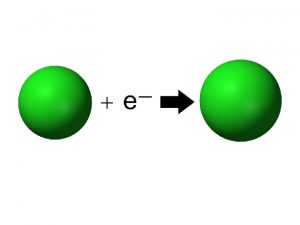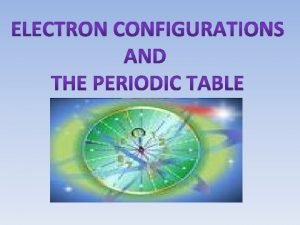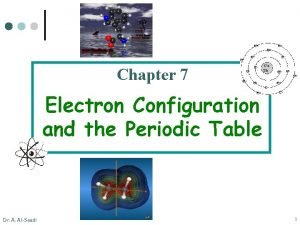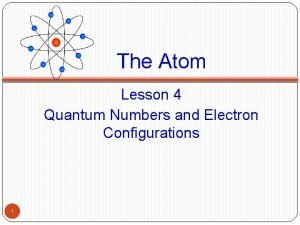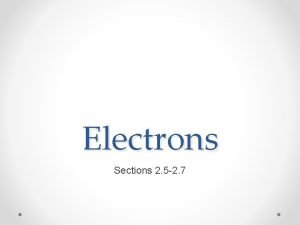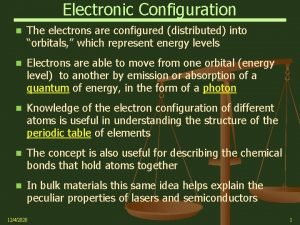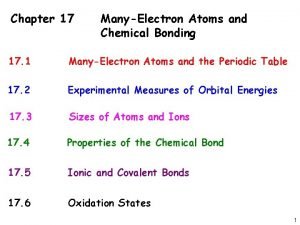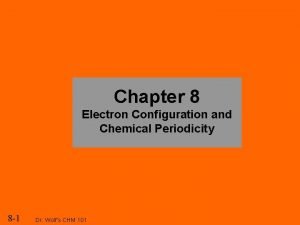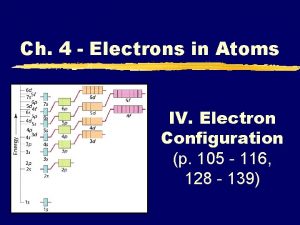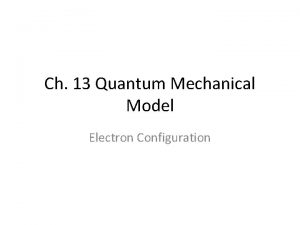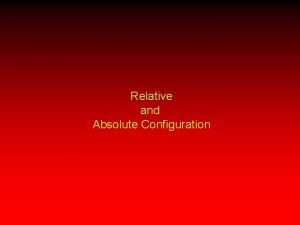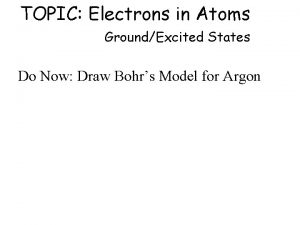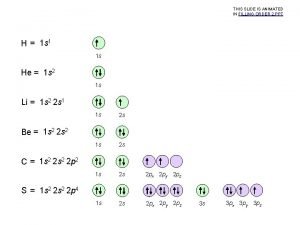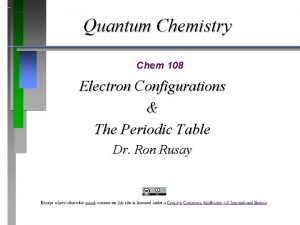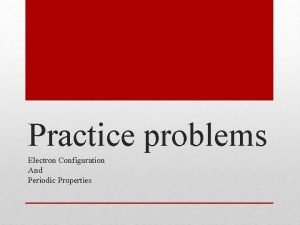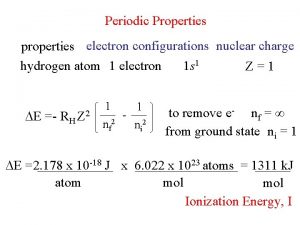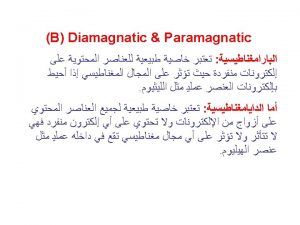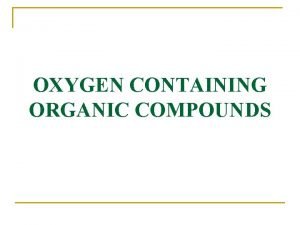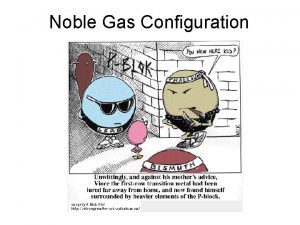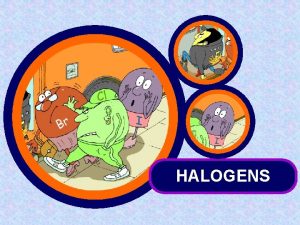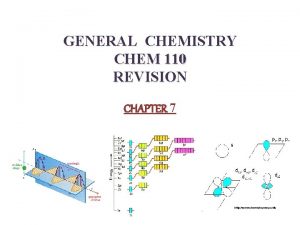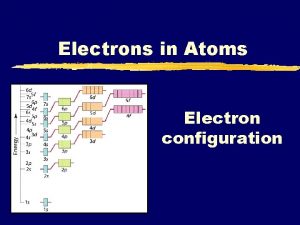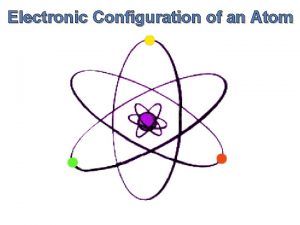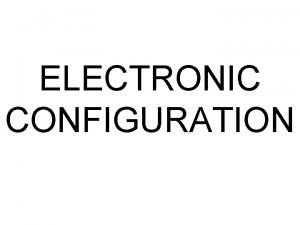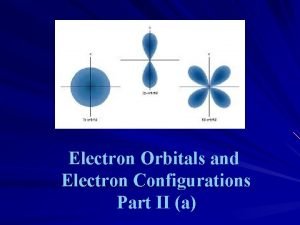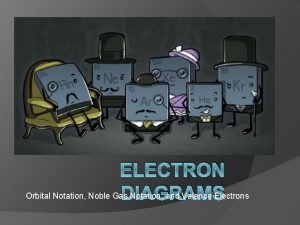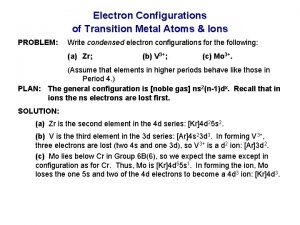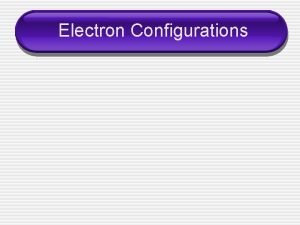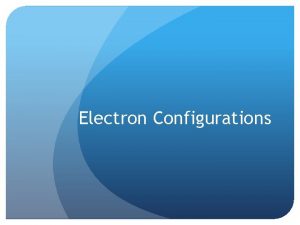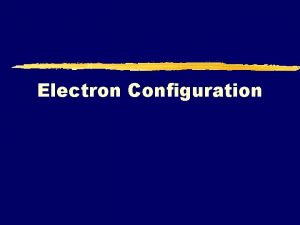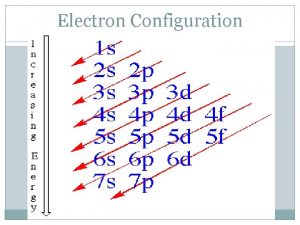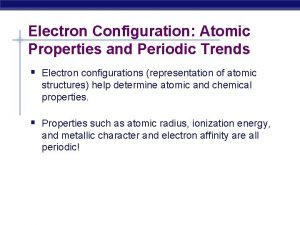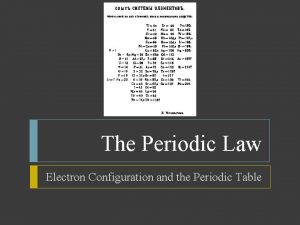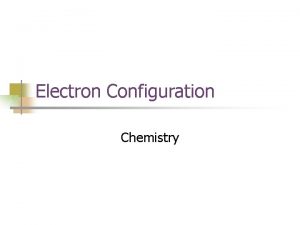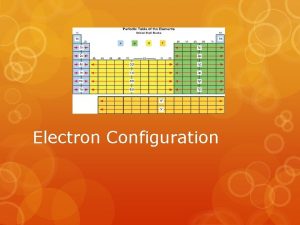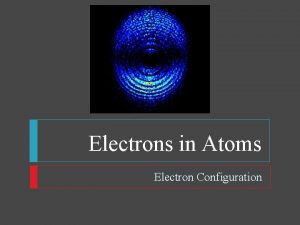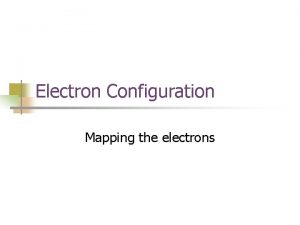Electron Configuration and Periodic Trends Na 1 s





































- Slides: 37

Electron Configuration and Periodic Trends Na: 1 s 2 2 p 6 3 s 1 Na: [Ne] 3 s 1

Electron Configurations • Electron configurations tells us in which orbitals the electrons for an element are located. • Three rules: – electrons fill orbitals starting with lowest n and moving upwards; – no two electrons can fill one orbital with the same spin (Pauli); – for degenerate orbitals, electrons fill each orbital singly before any orbital gets a second electron (Hund’s rule).

Filling Diagram for Sublevels Aufbau Principle

Electron Configurations • The electron configuration of an atom is a shorthand method of writing the location of electrons by sublevel. • The sublevel is written followed by a superscript with the number of electrons in the sublevel. – If the 2 p sublevel contains 2 electrons, it is written 2 p 2

Writing Electron Configurations • First, determine how many electrons are in the atom. Iron has 26 electrons. • Arrange the energy sublevels according to increasing energy: – 1 s 2 s 2 p 3 s 3 p 4 s 3 d … • Fill each sublevel with electrons until you have used all the electrons in the atom: – Fe: 1 s 2 2 p 6 3 s 2 3 p 6 4 s 2 3 d 6 • The sum of the superscripts equals the atomic number of iron (26)

Electron Configurations and the Periodic Table • The periodic table can be used as a guide for electron configurations. • The period number is the value of n. • Groups 1 A and 2 A have the s-orbital filled. • Groups 3 A - 8 A have the p-orbital filled. • Groups 3 B - 2 B have the d-orbital filled. • The lanthanides and actinides have the f-orbital filled.

Blocks and Sublevels • We can use the periodic table to predict which sublevel is being filled by a particular element.


Noble Gas Core Electron Configurations • Recall, the electron configuration for Na is: Na: 1 s 2 2 p 6 3 s 1 • We can abbreviate the electron configuration by indicating the innermost electrons with the symbol of the preceding noble gas. • The preceding noble gas with an atomic number less than sodium is neon, Ne. We rewrite the electron configuration: Na: [Ne] 3 s 1


Electron Configurations • • • Condensed Electron Configurations Neon completes the 2 p subshell. Sodium marks the beginning of a new row. So, we write the condensed electron configuration for sodium as Na: [Ne] 3 s 1 [Ne] represents the electron configuration of neon. Core electrons: electrons in [Noble Gas]. Valence electrons: electrons outside of [Noble Gas].

Valence Electrons • When an atom undergoes a chemical reaction, only the outermost electrons are involved. • These electrons are of the highest energy and are furthest away from the nucleus. These are the valence electrons. • The valence electrons are the s and p electrons beyond the noble gas core.

Predicting Valence Electrons • The Roman numeral in the American convention indicates the number of valence electrons. – Group IA elements have 1 valence electron – Group VA elements have 5 valence electrons • When using the IUPAC designations for group numbers, the last digit indicates the number of valence electrons. – Group 14 elements have 4 valence electrons – Group 2 elements have 2 valence electrons

Electron Dot Formulas • An electron dot formula of an elements shows the symbol of the element surrounded by its valence electrons. • We use one dot for each valence electron. • Consider phosphorous, P, which has 5 valence electrons. Here is the method for writing the electron dot formula.

Ionic Charge • Recall, that atoms lose or gain electrons to form ions. • The charge of an ion is related to the number of valence electrons on the atom. • Group IA/1 metals lose their one valence electron to form 1+ ions. – Na → Na+ + e- • Metals lose their valence electrons to form ions.

Predicting Ionic Charge • Group IA/1 metals form 1+ ions, group IIA/2 metals form 2+ ions, group IIIA/13 metals form 3+ ions, and group IVA/14 metals from 4+ ions. • By losing their valence electrons, they achieve a noble gas configuration. • Similarly, nonmetals can gain electrons to achieve a noble gas configuration. • Group VA/15 elements form -3 ions, group VIA/16 elements form -2 ions, and group VIIA/17 elements form -1 ions.

Ion Electron Configurations • When we write the electron configuration of a positive ion, we remove one electron for each positive charge: Na → 1 s 2 2 p 6 3 s 1 → Na+ 1 s 2 2 p 6 • When we write the electron configuration of a negative ion, we add one electron for each negative charge: O 1 s 2 2 p 4 → → O 21 s 2 2 p 6

Recap • We can Write the electron configuration of an element based on its position on the periodic table. • Valence electrons are the outermost electrons and are involved in chemical reactions. • We can write electron dot formulas for elements which indicate the number of valence electrons.

Recap • We can predict the charge on the ion of an element from its position on the periodic table.

General Periodic Trends • • • Atomic and ionic size Ionization energy Electronegativity Higher effective nuclear charge Electrons held more tightly Larger orbitals. Electrons held less tightly.

Atomic Size • Size goes UP on going down a group. • Because electrons are added further from the nucleus, there is less attraction. This is due to additional energy levels and the shielding effect. Each additional energy level “shields” the electrons from being pulled in toward the nucleus. • Size goes DOWN on going across a period.

Atomic Size decreases across a period owing to increase in the positive charge from the protons. Each added electron feels a greater and greater + charge because the protons are pulling in the same direction, where the electrons are scattered. Large Small

Which is Bigger? • Na or K ? • Na or Mg ? • Al or I ?

Ion Sizes Does the size go up or down when losing an electron to form a cation?

Ion Sizes + Li, 152 pm 3 e and 3 p Li + , 78 pm 2 e and 3 p Forming a cation. • CATIONS are SMALLER than the atoms from which they come. • The electron/proton attraction has gone UP and so size DECREASES.

Ion Sizes Does the size go up or down when gaining an electron to form an anion?

Ion Sizes F, 71 pm 9 e and 9 p F- , 133 pm 10 e and 9 p Forming an anion. • ANIONS are LARGER than the atoms from which they come. • The electron/proton attraction has gone DOWN and so size INCREASES. • Trends in ion sizes are the same as atom sizes.

Trends in Ion Sizes Figure 8. 13

Which is Bigger? • Cl or Cl- ? • K+ or K ? • Ca or Ca+2 ? • I- or Br- ?

Ionization Energy IE = energy required to remove an electron from an atom (in the gas phase). Mg (g) + 738 k. J ---> Mg+ (g) + e. This is called the FIRST ionization energy because we removed only the OUTERMOST electron 2+ Mg+ (g) + 1451 k. J ---> Mg (g) + e. This is the SECOND IE.

Trends in Ionization Energy • IE increases across a period because the positive charge increases. • Metals lose electrons more easily than nonmetals. • Nonmetals lose electrons with difficulty (they like to GAIN electrons).

Trends in Ionization Energy • IE increases UP a group • Because size increases (Shielding Effect)

st 1 Which has a higher energy? • Mg or Ca ? • Al or S ? • Cs or Ba ? ionization

Electronegativity, is a measure of the ability of an atom in a molecule to attract electrons to itself. Concept proposed by Linus Pauling 1901 -1994

Periodic Trends: Electronegativity • In a group: Atoms with fewer energy levels can attract electrons better (less shielding). So, electronegativity increases UP a group of elements. • In a period: More protons, while the energy levels are the same, means atoms can better attract electrons. So, electronegativity increases RIGHT in a period of elements.

Electronegativity

Which is more electronegative? • F or Cl ? • Na or K ? • Sn or I ?
 Electron configuration vs noble gas configuration
Electron configuration vs noble gas configuration Periodic trends electron affinity
Periodic trends electron affinity Periodic table electron configuration
Periodic table electron configuration Isoelectronic series
Isoelectronic series Periodic table tends
Periodic table tends Periodic family names
Periodic family names Quantum numbers and electron configuration
Quantum numbers and electron configuration 1s 22 s22 p63
1s 22 s22 p63 N and l electron configuration
N and l electron configuration Copper subshell configuration
Copper subshell configuration Diamagnetic elements
Diamagnetic elements Electronic configuration of mo (z=42)
Electronic configuration of mo (z=42) C n o f electron affinity
C n o f electron affinity Stability and electron configuration ch 4
Stability and electron configuration ch 4 E=h x v
E=h x v Absolute vs relative configuration
Absolute vs relative configuration Relative vs absolute configuration
Relative vs absolute configuration Absolute configuration vs relative configuration
Absolute configuration vs relative configuration Excited state electron configuration
Excited state electron configuration 3p4
3p4 Oganesson electron configuration
Oganesson electron configuration Periodic table practice problems
Periodic table practice problems Periodic table of elements 1s 2s
Periodic table of elements 1s 2s What is effective nuclear charge
What is effective nuclear charge Is p diamagnetic
Is p diamagnetic Electron configuration for oxygen
Electron configuration for oxygen Why are they called noble gases
Why are they called noble gases Why does halogen reactivity decrease down a group
Why does halogen reactivity decrease down a group Isoelectronic ions
Isoelectronic ions Orbital diagram for s
Orbital diagram for s Aluminium oxide bond
Aluminium oxide bond What does electron configuration mean
What does electron configuration mean Condensed electron configuration of calcium
Condensed electron configuration of calcium Electron rules opposite gender only
Electron rules opposite gender only What is the noble gas notation
What is the noble gas notation Spectrochemical series
Spectrochemical series Electron configuration arrow diagram
Electron configuration arrow diagram Silver electron configuration
Silver electron configuration

